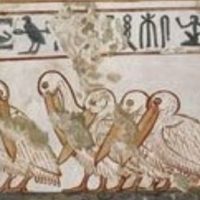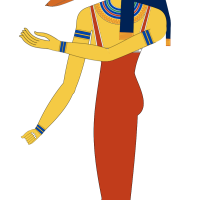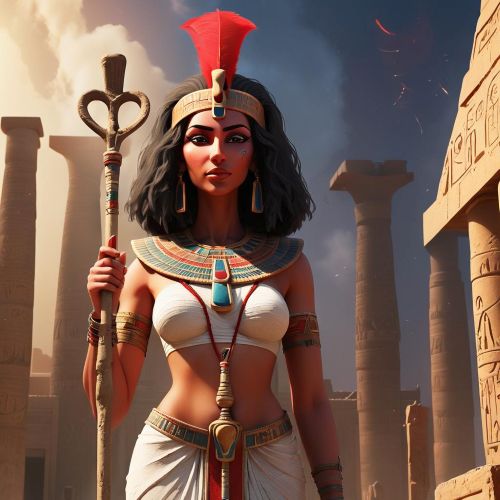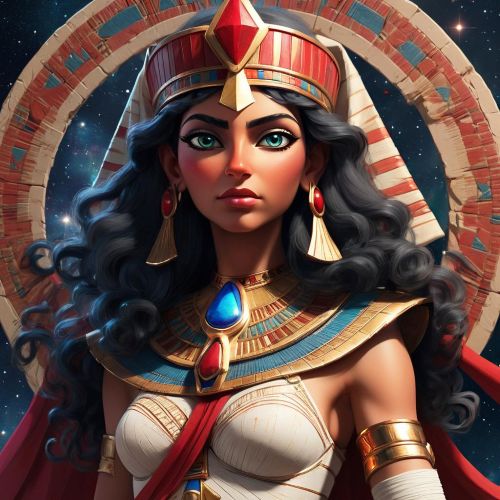Henet : The Pelican Goddess
Listen
At a glance
| Description | |
|---|---|
| Origin | Egyptian Mythology |
| Classification | Gods |
| Family Members | N/A |
| Region | Egypt |
| Associated With | Pelican, Protection, Fertility |
Henet
Introduction
Henet, whose name translates directly to “pelican” in ancient Egyptian, is a lesser-known yet symbolically rich goddess of protection, rebirth, and spiritual passage. Mentioned in the Pyramid Texts of the Old Kingdom, she is one of the earliest avian deities in Egyptian mythology. Though she never achieved the fame of Isis or Hathor, Henet’s image appears in funerary art and religious inscriptions as a divine guardian who helps the souls of the deceased journey safely through the afterlife. She embodies maternal care and divine protection, her pelican form symbolizing the nurturing and life-giving aspects of water and renewal. Revered as “Mother of the King,” Henet represented the spiritual motherhood that connected divine and royal realms, ensuring the pharaoh’s safe rebirth in the afterlife.
Physical Traits
Henet is most often depicted as a pelican or as a woman with the head of a pelican. This bird, though not as commonly worshipped as the falcon or ibis, carried powerful symbolism in ancient Egypt. The pelican’s distinctive pouch and habit of scooping fish from the Nile inspired associations with protection, sustenance, and purification. Egyptians observed the pelican as a caring and self-sacrificing creature, often seen shielding its young from harm, which made it an ideal emblem of divine guardianship. In tomb reliefs and papyri, Henet’s open beak was symbolic of resurrection — the mouth of the pelican represented the tomb opening through which the spirit could rise into the sunlight. This connection between the bird’s anatomy and the architecture of tombs underscored Henet’s role as a spiritual bridge between the world of the living and the dead.
Family
The ancient texts provide little information about Henet’s divine lineage or relationships. However, her title “Mother of the King” implies a sacred maternal role within the royal and spiritual hierarchy. In Egypt, this title was not merely symbolic; it was reserved for deities who embodied protective motherhood toward the pharaoh, who was considered both a god and a mortal ruler. Thus, Henet may have represented the divine maternal essence that ensured the eternal well-being of kings in life and death. This role aligns her with other protective goddesses such as Nekhbet, the vulture goddess of Upper Egypt, and Wadjet, the cobra goddess of Lower Egypt. Henet’s maternal symbolism may have also extended beyond kingship, embodying the universal principle of care and resurrection that all souls required in their passage through the Duat, or underworld.
Other names
Henet’s name appears in several variations in ancient inscriptions, such as Hnt-mryt (“Beloved of the Pelican”) and Hnt-nfr (“Beautiful of the Pelican”). These names reflect her close identification with her sacred bird form. In some texts, she is simply referred to as “The Pelican,” emphasizing her embodiment of the creature itself rather than her individuality as a distinct anthropomorphic goddess. Unlike many Egyptian deities who accumulated numerous epithets, Henet’s titles remained few but meaningful, each underscoring her nurturing, protective, and royal connections. The consistency of her association with the pelican across different dynastic periods indicates that her identity was firmly rooted in the symbolic significance of the bird rather than in elaborate mythology or temple cults.
Powers and Abilities
Henet’s powers are primarily protective and transformative, deeply tied to the spiritual journey after death. In the Pyramid Texts, she is invoked as a guardian who ensures the safe passage of souls through the perilous regions of the underworld. Her pelican form serves as a divine shield, capable of warding off serpents, evil spirits, and the forces of chaos that threatened the deceased. The pelican’s act of scooping fish from the Nile was interpreted as a metaphor for removing impurities and dangers from the soul’s path.
One of the most evocative references to her appears in the phrase “The mouth of the pelican is opened for me,” found in funerary texts. This statement represents the symbolic opening of the tomb and the rebirth of the deceased into the light — a process akin to resurrection. Through this act, Henet was seen as a psychopomp-like figure, guiding the spirit from darkness into renewal, similar in function to Anubis. Beyond her funerary role, Henet was also a deity of fertility and abundance. Pelicans, being dependent on water, were linked to the flooding of the Nile, which renewed the land and ensured agricultural prosperity. Thus, Henet’s blessings extended from the underworld to the physical world, encompassing both spiritual and material forms of sustenance.
Modern Day Influence
Although Henet is no longer an object of worship, her imagery and symbolism continue to appear in modern explorations of Egyptian mythology and art. Museums and academic studies often highlight her presence in tomb reliefs as evidence of the Egyptians’ deep connection between nature and spirituality. Modern Egyptologists regard her as a personification of maternal protection and rebirth — a lesser but vital figure who embodies the everyday faith of the ancient people rather than the grand myths of state religion.
The pelican, central to her identity, has endured as a universal symbol of self-sacrifice and renewal. In Christian iconography, the pelican came to represent Christ’s sacrifice — an echo of the ancient Egyptian interpretation of the bird as a nurturer willing to give life for others. This continuity of symbolism suggests that Henet’s spiritual archetype may have indirectly influenced later religious metaphors across cultures.
In literature and visual art, modern creators have reinterpreted Henet as a figure of transcendence and divine compassion. Her role as a guide between life and death resonates with contemporary spiritual movements that emphasize the cyclical nature of existence and the guardianship of nature spirits. Neo-pagan and Kemetic (Egyptian revivalist) traditions occasionally invoke Henet as a protector during rituals involving transformation, renewal, or grief, recognizing her as a goddess of passage and healing.
Henet’s legacy, though subtle, remains profound. She represents a quieter form of divinity — one not rooted in grand temples or state worship but in the intimate, personal realm of protection, nourishment, and rebirth. Her pelican form continues to evoke the sacred relationship between the living and the departed, between water and life, and between motherhood and spiritual renewal. Through her, we glimpse the Egyptian understanding that even the smallest creatures, when viewed through the lens of faith, could embody the divine essence of care, guidance, and eternal life.
Related Images
Source
Allen, P. J., & Saunders, C. (2018). Henet – The Egyptian Goddess of Mystery. Godchecker. Retrieved from https://www.godchecker.com/egyptian-mythology/HENET/
Hart, G. (1986). A Dictionary of Egyptian Gods and Goddesses. Routledge.
Henadology. (n.d.). Henet. Retrieved from https://henadology.wordpress.com/theology/netjeru/henet/
Hornung, E. (1992). Conceptions of God in Ancient Egypt: The One and the Many. Cornell University Press.
Redford, D. B. (Ed.). (2001). The Oxford Encyclopedia of Ancient Egypt. Oxford University Press.
Simple Wikipedia. (2020). Henet. Retrieved from https://simple.wikipedia.org/wiki/Henet
Wikipedia. (2022). Henet. Retrieved from https://en.wikipedia.org/wiki/Henet
Reddit Essays Archive. (2021). The Goddess Henet. Retrieved from https://www.reddit.com/r/Cowofgold_Essays/comments/s564t7/the_goddess_henet/
Frequently Asked Questions
What is lorem Ipsum?
I am text block. Click edit button to change this text. Lorem ipsum dolor sit amet, consectetur adipiscing elit. Ut elit tellus, luctus nec ullamcorper mattis, pulvinar dapibus leo.
What is lorem Ipsum?
I am text block. Click edit button to change this text. Lorem ipsum dolor sit amet, consectetur adipiscing elit. Ut elit tellus, luctus nec ullamcorper mattis, pulvinar dapibus leo.
What is lorem Ipsum?
I am text block. Click edit button to change this text. Lorem ipsum dolor sit amet, consectetur adipiscing elit. Ut elit tellus, luctus nec ullamcorper mattis, pulvinar dapibus leo.
What is lorem Ipsum?
I am text block. Click edit button to change this text. Lorem ipsum dolor sit amet, consectetur adipiscing elit. Ut elit tellus, luctus nec ullamcorper mattis, pulvinar dapibus leo.
What is lorem Ipsum?
I am text block. Click edit button to change this text. Lorem ipsum dolor sit amet, consectetur adipiscing elit. Ut elit tellus, luctus nec ullamcorper mattis, pulvinar dapibus leo.











